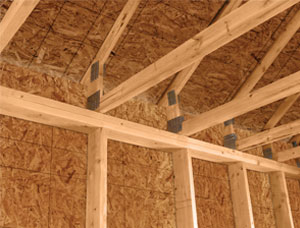Raised-heel trusses, also known as energy-heel trusses, deliver cost-effective energy performance, especially when used with continuous plywood or OSB sheathing. Framing with raised-heel trusses and continuously sheathing exterior walls improves structural and energy performance and offers many savings that benefit both the builder and the homeowner.
What is a Raised-Heel Truss?
A raised-heel truss is identical to a conventional truss except for one difference: it is raised higher, with a “heel” that extends up from the top of the wall and elevates the truss at the building’s edges. Raising the truss higher has two big advantages: it greatly simplifies attic ventilation, and it leaves ample room for insulation above exterior wall top plates.

Advantages to Raised-Heel Trusses
 Easy to build
Easy to build
Raised-heel trusses are installed the same way as conventional trusses, so no special tools or know-how is needed to build them.
- Overlapping heels of trusses with wall sheathing saves money
Continuous plywood or OSB sheathing can completely eliminate code-required blocking, saving time and expense (provided that the requirements in section R602.10.8.2 of the 2015 International Residential Code are met.)
- Savings on insulation costs
Raised-heel trusses do not compress the attic insulation over the top plate, which compromises the insulation value. Because raised-heel trusses are high enough to leave the insulation value intact, the energy code allows for use of less insulation for the entire ceiling system when raised-heel trusses are used.
- Meet building codes and enhance structural performance
When raised-heel trusses are used in combination with overlapping continuous wood structural panel sheathing, the wall-to-truss connection is far superior to conventional means like toenailing. This results in walls with improved resistance to lateral forces like winds or seismic activity.
- Improved HERS scores
HERS index ratings could be 4 to 6 points lower for homes with raised-heel trusses.
- A more comfortable home
Improved ceiling insulation eliminates cold spots at the top of exterior walls, resulting in a more stable temperature.